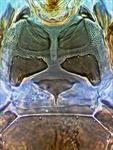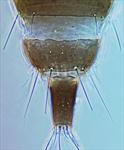
Female

Antenna

Head & pronotum

Fore tarsus & tibia

Prosternites

Pelta & tergites II–III

Abdominal segments VIII–X (tube)
Female with wings shorter than width of thorax, rarely with complete wings. Body, legs and antennae mainly brown, tarsi yellow also apices of tibiae; antennal segment III yellowish brown. Antennae 8-segmented; segment III with one sense cone, IV with 3 sense cones. Head longer than wide; dorsal surface with little sculpture, ocelli small; postocular setae slender, capitate, wide apart; maxillary stylets retracted to postocular setae, more than one third of head width apart. Pronotum with little sculpture; four pairs of slender, capitate major setae, anteromarginals minute; prosternal basantra large, almost as long as wide; mesopresternum transverse. Fore tarsus with very small curved tooth at inner apex. Metanotum without sculpture. Fore wing very small, about as long as median length of mesonotum; when fully developed with three or four duplicated cilia, and two capitate sub-basal setae. Pelta reticulate, anterior margin rounded; tergites III–VII with two pairs of weak, or very weak, sigmoid setae; tergite VIII setae S1 short and bluntly pointed, S2 slender and capitate; tergite IX setae S1 capitate, S2 long and acute; anal setae slightly longer than tube.
Almost 50 species are listed in the genus Karnyothrips, but it is questionable how many of these should be placed in the same genus. A key to 14 species from Central and South America that have been placed in this genus is given by Mound & Marullo (1996), and a key to 11 species from Japan is given by Okajima (2006), whilst Stannard (1968) included three North American species within his treatment of the genus Haplothrips. The problems in distinguishing between these two genera are discussed by Mound & Minaei (2007). K. longiceps differs from K. flavipes in having setae S1 on the eighth abdominal tergite pointed rather than capitate; both species have capitate S1 setae on the ninth tergite.
Possibly predatory on other small arthropods. Reported to be associated with prairie grasses, Andropogon spp. (Stannard, 1968), but also on various dead branches (Cott, 1956).
Possibly originally from North America, and widespread across USA, through California and Mexico, to Chile and Peru.
PHLAEOTHRIPIDAE, PHLAEOTHRIPINAE
Zygothrips longiceps Hood, 1908: 364
Cephalothrips errans Moulton, 1911: 42.
Cott HE (1956) Systematics of the suborder Tubulifera (Thysanoptera) in California. University of California, Berkeley, Publications in Entomology 13: 1–216.
Mound LA & Marullo R (1996) The Thrips of Central and South America: An Introduction. Memoirs on Entomology, International 6: 1–488.
Mound LA & Minaei K (2007) Australian insects of the Haplothrips lineage (Thysanoptera – Phlaeothripinae). Journal of Natural History 41: 2919–2978.
Okajima S (2006) The Suborder Tubulifera (Thysanoptera). The Insects of Japan 2: 1–720. The Entomological Society of Japan, Touka Shobo Co. Ltd., Fukuoka.
Stannard LJ (1968) The Thrips, or Thysanoptera, of Illinois. Bulletin of the Illinois Natural History Survey 29: 213–552.